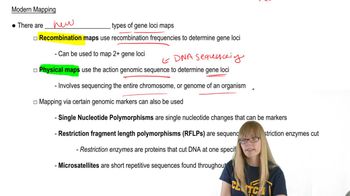Table of contents
- 1. Introduction to Genetics51m
- 2. Mendel's Laws of Inheritance3h 37m
- 3. Extensions to Mendelian Inheritance2h 41m
- 4. Genetic Mapping and Linkage2h 28m
- 5. Genetics of Bacteria and Viruses1h 21m
- 6. Chromosomal Variation1h 48m
- 7. DNA and Chromosome Structure56m
- 8. DNA Replication1h 10m
- 9. Mitosis and Meiosis1h 34m
- 10. Transcription1h 0m
- 11. Translation58m
- 12. Gene Regulation in Prokaryotes1h 19m
- 13. Gene Regulation in Eukaryotes44m
- 14. Genetic Control of Development44m
- 15. Genomes and Genomics1h 50m
- 16. Transposable Elements47m
- 17. Mutation, Repair, and Recombination1h 6m
- 18. Molecular Genetic Tools19m
- 19. Cancer Genetics29m
- 20. Quantitative Genetics1h 26m
- 21. Population Genetics50m
- 22. Evolutionary Genetics29m
4. Genetic Mapping and Linkage
Mapping Genes
Problem 35b
Textbook Question
Based on previous family studies, an autosomal recessive disease with alleles A and a is suspected to be linked to an RFLP marker. The RFLP marker has four alleles, R₁, R₂, R₃, and R₄. The accompanying pedigree shows a three-generation family in which the disease is present. The gel shows the RFLP alleles for each family member directly below the pedigree symbol for that person. After determining the genotypes for the RFLP and disease gene for each family member, answer the following questions. Is there any evidence of recombination in this pedigree? If so, identify the recombinant individuals and illustrate the recombination that has occurred.
 Verified step by step guidance
Verified step by step guidance1
<Step 1: Understand the genetic context. The disease is autosomal recessive, meaning an individual must have two copies of the recessive allele 'a' to express the disease phenotype. The RFLP marker has four alleles: R₁, R₂, R₃, and R₄.>
<Step 2: Analyze the pedigree. Identify affected individuals (those with the disease) and their genotypes. Affected individuals will have the genotype 'aa'.>
<Step 3: Determine the RFLP genotypes for each family member using the gel provided. Match the RFLP alleles to each individual based on their position in the pedigree.>
<Step 4: Look for evidence of recombination. Recombination occurs when the alleles of the disease gene and the RFLP marker do not segregate together as expected. Compare the RFLP genotypes of affected individuals to their parents to identify any discrepancies.>
<Step 5: Identify recombinant individuals. If an affected individual has an RFLP genotype that does not match the expected inheritance pattern from their parents, they may be a recombinant. Illustrate the recombination by showing the unexpected allele combinations.>
Recommended similar problem, with video answer:
 Verified Solution
Verified SolutionThis video solution was recommended by our tutors as helpful for the problem above
Video duration:
3mPlay a video:
Was this helpful?
Key Concepts
Here are the essential concepts you must grasp in order to answer the question correctly.
Autosomal Recessive Inheritance
Autosomal recessive inheritance refers to a pattern where two copies of a mutated gene (one from each parent) are necessary for an individual to express a trait or disease. In this case, alleles A (normal) and a (mutated) determine the presence of the disease. Individuals with genotype aa will exhibit the disease, while those with AA or Aa will be unaffected. Understanding this inheritance pattern is crucial for analyzing the pedigree and determining which individuals may carry the disease allele.
Recommended video:
Guided course

Autosomal Pedigrees
Restriction Fragment Length Polymorphism (RFLP)
RFLP is a molecular technique used to analyze the variations in DNA sequences. It involves digesting DNA with specific restriction enzymes, resulting in fragments of different lengths that can be separated by gel electrophoresis. The presence of different alleles (R₁, R₂, R₃, R₄) at the RFLP marker can help identify genetic linkage to the disease gene. This technique is essential for determining the genotypes of family members in the pedigree and assessing potential recombination events.
Recommended video:
Guided course

Mapping with Markers
Recombination
Recombination is the process by which genetic material is exchanged between homologous chromosomes during meiosis, leading to new allele combinations. In the context of the pedigree, identifying recombinant individuals involves comparing their RFLP alleles with those of their parents. If an individual has a combination of alleles that differs from both parents, it indicates that recombination has occurred. This concept is vital for understanding genetic diversity and the inheritance patterns observed in the family.
Recommended video:
Guided course

Recombination after Single Strand Breaks
Related Videos
Related Practice





